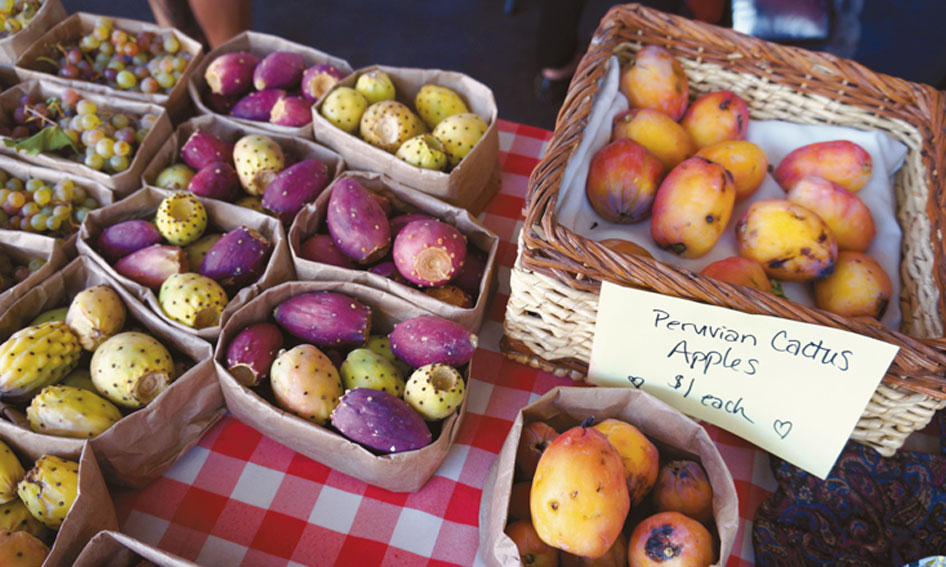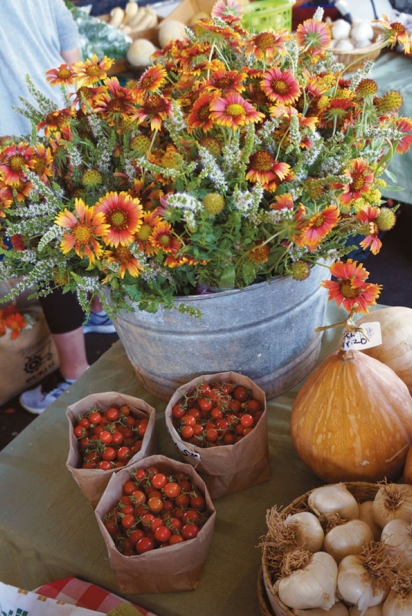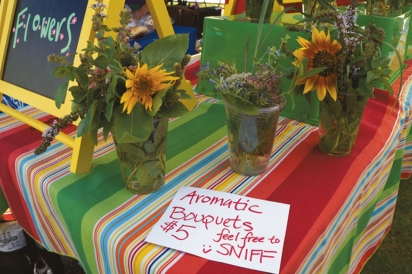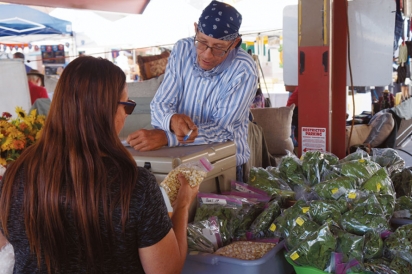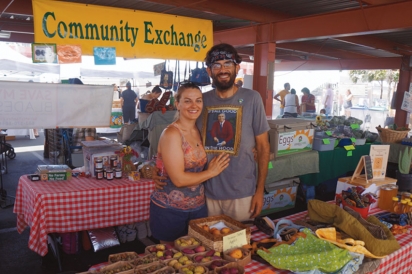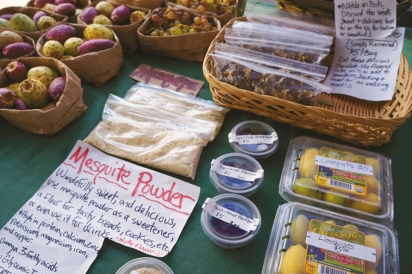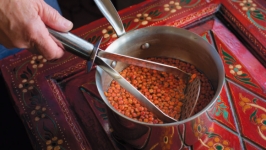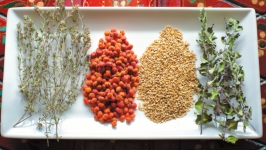The Community Exchange Table: A Farmers Market Within the Farmers Market
Figs and prickly pear fruit fill a stretch of the table next to bags of tomatoes and herbs. Near the bouquets of flowers are handmade cloth bags made from reused materials, and tortillas with zucchini blossoms garnishing their centers. Then there is the variety of body care products and jars of herbal teas, cookies and eggs. It’s the Community Exchange table at the Phoenix Public Market.
Community Exchange is an often-changing group of people who come together to sell goods at a single farmers market booth. The group started in the fall of 2009 at the Phoenix Public Market as a place for backyard farmers, those with community garden plots and others who might not be able to fill their own booths. In exchange for 20% of sales, Community Exchange handles the logistics of a market space; individual vendors just need to bring their items to the table before the market opens.
Chip Satterlund helped found the group in 2009 and is currently the director of Community Exchange.
“It promotes local economy and local business incubation,” he says. “It provides local, good-quality produce and veggies to the community.”
While Community Exchange’s structure makes it a unique organization, it is the vendors who give it life. Meet a few of the contributors here:
Emily Heller, Et Tu Frute/Bene Vivendo, basks not just in the appearance of flowers or the taste of fresh tomatoes, but in how plants delight multiple senses. She sells bouquets of vibrant and interestingly textured flowers bundled with fragrant fresh herbs. She grows tomatoes that pop with sweetness in the mouth and delight the eye with stripes and variants of color.
In 2012, she and her family moved into the house where they live in Tempe. There was one raised bed in the backyard.
Since then, Heller has added more flowerbeds and growing spaces.
“Every nook and cranny has the potential to grow something and we’ve tried to develop that,” she says. She now has a backyard full of tomatoes, blackberries, lemongrass, hibiscus, a variety of flowers—many of them edible—and other herbs and plants.
Partnering with Community Exchange allowed her to start selling before her gardens expanded. This fall, she plans to open her own table at the Uptown Farmers Market. Named Et Tu Frute when part of Community Exchange, Heller’s farm will re-introduce itself as Bene Vivendo, “living well” in Italian.
Charles S. Calbom, Hadley Farmship, says “First and foremost, I’m an environmentalist. In response to peak oil and my knowledge of healthy eating, my goal was to grow food without petroleum inputs. And I made it, except for my bike tires [used to bike produce to the farmers market] and the deliveries of my seeds.”
Calbom is one of the original vendors through Community Exchange. For several years, he oversaw the booth at the Phoenix Public Market, but lately has focused solely on growing produce.
He gardens in south Phoenix on just under a half acre Calbom calls “Hadley Farmship,” inspired by the location’s street address and the concept of an Earthship, a type of eco-friendly structure built from recycled and sustainable materials. The property has produced a variety of greens, melons, herbs, figs and corn for hominy for several years already. Calbom is especially enthusiastic about the greens.
“Eating a variety of greens at a decent quantity on a regular basis, nothing has changed my life more,” Calbom says. He then adds with a chuckle, “except maybe getting married.”
Kenny Besaw, foraging, is a familiar face for Community Exchange customers at the Phoenix Public Market. He has run the stand for several years.
Besaw first gardened with his stepfather, Charles S. Calbom, then established his own parcel in a Phoenix community garden. It was on walks to tend that plot, passing by citrus trees and cactus plants full of fruit, that he realized how much food was going unharvested around Phoenix.
Now, Besaw and girlfriend, Ashley Houp, Wild Green Roots, collect some of that otherwise ungathered produce to sell through Community Exchange. Many times that includes knocking on people’s doors asking for permission to gather the fruit they see in people’s yards.
“People are often really grateful it gets picked,” Houp says.
“They want us to take it, so it’s not getting wasted.”
Sometimes, Besaw and Houp get to educate homeowners about what items are edible in their yards. The barrel cactus and saguaro cactus are common in Phoenix-area landscaping, but homeowners are often surprised to learn they can eat the fruit.
Houp and Besaw also use signs and conversations to educate market customers about their rarer products. Along with more common items like figs, berries and citrus, they often sell carob, mesquite, creosote and cactus fruit. Houp also uses certain items in the Wild Green Roots body care products she makes and sells at the table.
Community Exchange has opened tables in several Valley farmers markets but has been most consistent at its original space at Saturday’s Phoenix Public Market and at the Wednesday and Saturday Uptown Farmers Market in Phoenix. Like some other farmers, it is certified to accept Women, Infant, Children checks for qualifying items, Supplemental Nutrition Assistance Program Electronic Benefits Transfer cards (SNAP EBT) and Double Up Foodbucks. You can follow Community Exchange on Facebook (facebook.com/communityexchangetable/) and Instagram (instagram.com/community.exchange.table_/).
If you’d like to become a member, the best way to get involved is to just stop by the Community Exchange table at the markets.


